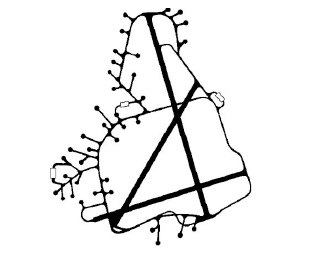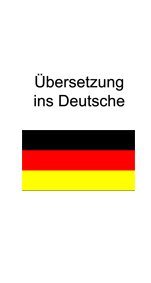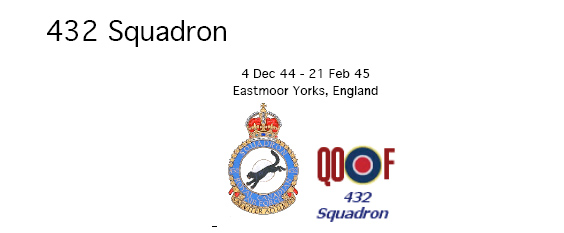
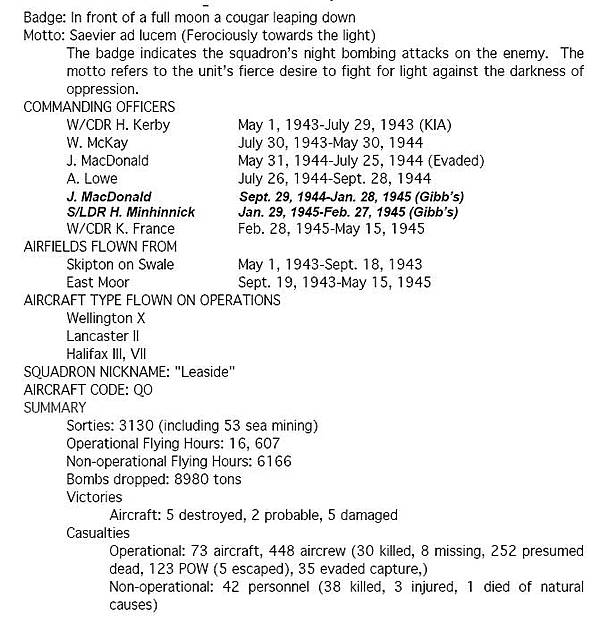
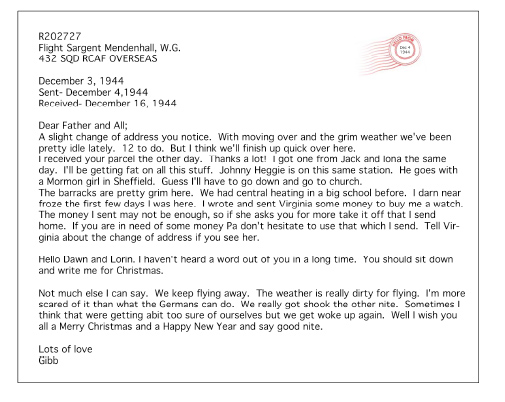
December 4, 1944 (Mission 17)
Joined the 432 squadron.
Gibb thought he had only 12 more missions to do.
Taking off at 4:39 p.m. flying Halifax QO-U.
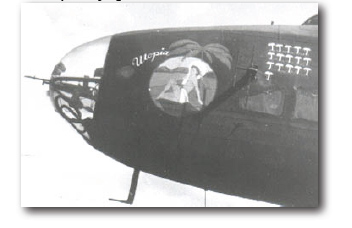
"Utopia" Halifax VII RG-478 QO-U flew a total of 17 Sorties 144 Halifaxes from 408, 415, 420, 424, 425, 426, 427, 429, 432, and 433 squadrons were joined by 46 Lancasters from 419, 428 and 431 squadrons on an attack at Karlsruhe. The crews were over the target at between 17,000 and 19,000 feet, releasing 854,000 lbs of high explosives and 678,000 lbs of incendiaries. According to reports, bombing was accurate with severe damage being caused. Among the factories destroyed was the important Durlacher Machine-tool building. F/O F. Jeffery from 432 Squadron was hit by flak, not serious. F/O J. Hamilton and crew, flying Halifax VII NP-802 coded QO-S, were attacked by an unidentified twin engine enemy aircraft, there was no claim or damage. P/O G. Sherlock landed at Elvington on return.
6 hours and 45 minutes in the air.
December 5/6, 1944 (Mission 18)
Taking off at 4:09 p.m. flying Halifax QO-Z
140 Halifaxes from 408, 415, 420, 424, 425, 426, 427, 429, 432, and 433
Squadrons were joined by 59 Lancasters from 419, 428, 431, and 434 Squadrons on an attack at Osnabruck. The crews were over the target at between 16,000 and 21,000 feet, releasing 1,310,000 lbs of high explosives and 193,000 lbs of
incendiaries. According to reports, the attack was scattered but the railyards
and a munitions factory were damaged.
F/O F. Jeffery from 432 Squadron was hit by flak, there were holes in the
fuselage, tail plane and rear turret. F/Lt W. Miller landed at North Creake on
return. F/ O E. Patzer landed at Woodbridge on return.
F/O G. Spiers RCAF and crew, flying Halifax VII NP-695 coded QO-K, failed to
return from this operation.
Sgt J. Jonas RAF–POW
W/O2 P. Callaghan RCAF–POW
F/O C. Wilkinson RCAF–POW
P/O S. Soles RCAF–POW
F/Sgt H. Quinn RCAF–POW
W/O1 J. Chalmers RCAF
5 crew were POWs and 2 were killed.
6 hours and 10 minutes in the air.
Letter to Thom Evanson from Ralph Rhea:
Ft. Macleod
August 26, 1992
Dear Tom
Relative to our phone conversation, we found the letter and Im enclosing a copy
of it for your use.
Reading it again after all this time has been a little nostalgic to say the
least. Your mother could probably tell you more about some of the Raymond Boys (Men) he mentioned. I know their names and them also but because of our age differences and lack of contact they are just names to me.
Hope this in some small way helps you to understand and better appreciate your
Uncle Gibb.
Sincerely
Ralph Rhea
12 Dec 1944
PT. Rhea R.W 19193891
B-Company, 54st Inhtng. BNCamp Wolters, TexasUSA.
Dear Ralph
Hello old cock how fares the battle, not to grimly I hope. For myself its not to
badexcept for a little pneumonia, rheumatism, arthritis etc. picked up in this beautiful mildclimate of jolly old England. I daresn’t go near a gun for fear
the temptation might proveto great and I would take the easy way out. Lordy
Lordy what a climate. I’m telling you
if you can survive this the Germans haven’t got a chance. It was really good to hear from you Ralph, I enjoyed your letter very much. From it I gathered you’ve joined a lot tougher outfit than this I’m in. We do nothing but clean
the occasional gun and our trips are few and far between. I’ve done 20 trips, 10
more to do and I’ve finished. Then I hope to go straight home. I’ve applied for a commission but I’d just love to sleep till noon, wear a scarf around instead of a tie etc. Personally I don’t give a damn. My WoII is about due and over here you get them the day there due.
Johnny Hicken was at 408. I’ve run into Mell Depew, Stuart Robinson and quite a
few Raymonites. I’m situated fairly close to York and Leeds and there’s some pretty good women around. I go with a girl in Leeds who wouldn’t mind crossing the Atlantic. She’s not bad. Sometimes I think its not a bad idea. Be sure and look me up if you have the misfortune to be sent to this “place”. I know how you feel about your life when at home.
I sometimes wonder what the matter was with me when I was making my Dad’s and
yourMother’s life miserable by being such an ass but I hope to compensate in
some small way. I hope this reaches you in time to wish you and B com a Merry and Happy New Year.
All the Best
Gibb
R202727
F/S Mendenhall#432 SOD
RCAF Overseas
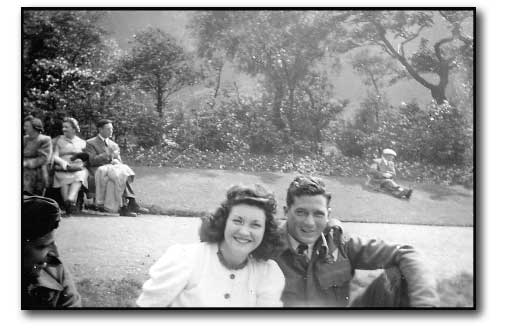
- Girl Friend, Gibb
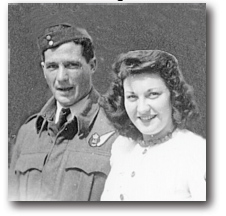
December 9, 12, 1944
3 hours and 35 minutes training and exercise.
Hitler gambled on one last great throw of the dice-his counter-at tack into the
Ardennes code-named Wacht am Rhein and subsequently known to the allies as the
Battle of the Bulge. Weather as the great equalizer, and surprise enabled it to
attain a
brief momentum. For well over a week, leaden, drizzly skies kept the Allied air
forces
away from the battlefield proper.
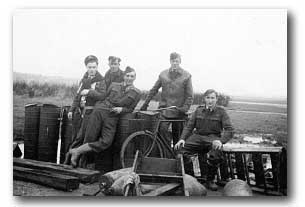
- Ground Crew
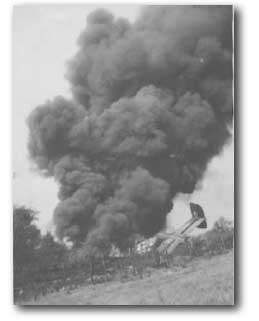
- Halifax from 432 Squadron crashed on take-off.
December 18, 1944 (Mission 19)
Taking off at 3:15 a.m. flying Halifax QO-Z 188 Halifaxes from 408, 415, 420, 424, 425, 426, 427, 429, 432, 433, and
434 Squadrons were joined by 42 Lancasters from 419, 428, and 431 Squadrons on an attack at Duisberg. The crews were over the target at between 17,000 and 21,000 feet, releasing 1,636,000 lbs of high explosives and 258,000 lbs of incendiaries.
According to reports, severe damage was caused. F/Lt E. Hayes and crew from 432 Squadron, flying Halifax VII NP-705 coded QO-Y, were attacked by a JU-88, there was no claim or damage. They landed at
Skellingthorpe on return due to poor weather at base. F/Lt L. Kropf, F/O A. Clarke, F/O J. Mills, F/O L.
Loppe, F/O C. Hemming, F/O N. Patterson, F/O A. Bews, F/O G. Barron, F/Lt W. Miller, and F/O A. Potter landed at Skellingthorpe on return due to poor weather at base. F/O J. Hamilton landed at Hurn on return due to poor weather at base. F/O G. Peaker landed at Fulbeck on return due to poor weather at base. F/O F. Baxter landed at Manston on return due to poor weather at base.
F/O M. Krakowsky RCAF–POW and crew, flying Halifax VII NP-699 coded QO-O,
was involved in a mid air collision over Belgium with LV-810 from 10 squadron.
P/O M. Boylan RAF
F/O R. Cann RCAF
F/O G. Wilson RCAF
P/O A. Blayney RCAF
P/O S. Zadorozny RCAF
P/O J. Green RCAF
Only the pilot survived.
F/O D. McKinnon RCAF and crew, flying Halifax VII NP-701 coded QO-G, failed to
return from this operation.
F/Sgt A. Eccleston RAF
F/O D. Hitchcock RCAF
F/O G. March RCAF
P/O E. Harvey RCAF
P/O E. Farrell RCAF
Sgt J. Harvey RCAF
Only the rear gunner and pilot survived.
6 hours and 40 minutes in the air, landing at Bury. St. Edmunds.
Gibb now having a total of 21 hours and 45 with the 432 squadron.
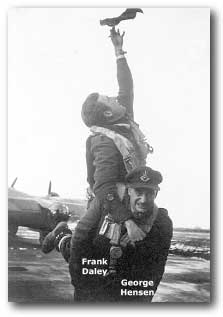
Bomber Command, together with the Eighth Air Force and the allied tactical air forces, did much to help seal off von Rundstedt’s spearheads. Most of his troops and equipment had to drain on the east band of the Rhine, very little transport of any kind could move by day, and before the end of the year Wacht am Rhein simply petered out.
Most sorties mission during the month of
November and December of 1944 were given to the destruction of the enemy’s synthetic oil plants which was less than one in four. Pure area raids-against Munich, Munster, Neus, Duesburg, Hagen, EEssen, Ludwigshaven, Witten and Ulm-totalled about 40%, and attacks on transportation targets accounted for most of the rest. Even so, bomber Command's greatest successes during this period
came against the oil plants of western Germany-Gelsenkirchen, Wanne-Eickel, Castrop-Rauxell, Harburg, Dortmund, Homberg, Bottrup, Sterkrade, and Osterfeld-and they came as much by night as by day. Indeed, by late November the western refineries had been very heavily damaged. Production for five major synthetic plants fell from 46,750 tons in January 1945 to 11,260 in March and 730 in April.
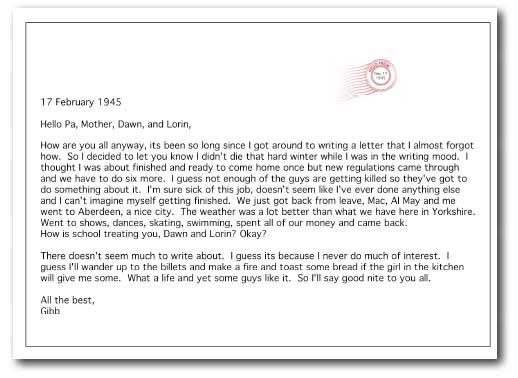
December 18, 1944
Taking off at 3:33 from Bury St. Edmunds to base.
January 2, 1945 (Mission 20)
Taking off at 2:56 pm flying Halifax Q0-F.
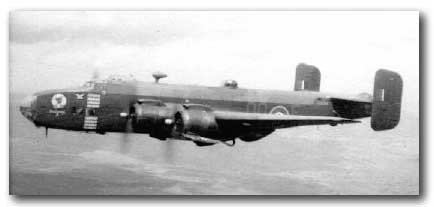
- Halifax NP-697 QO-F--Ferdinand II of 432 Squadron
156 Halifaxes from 408, 415, 420, 424, 425, 426, 427, 429, 432, and 433
squadrons were ordered to attack the I. G. Farben factory at Ludwigshafen. The
crews were over the target at between 17,000 and 20,000 feet, releasing 938,000 lbs of high explosives and 223,000 lbs of incendiaries. According to reports there was severe damage to the factory and many other industrial firms in the area plus the rail repair sheds were destroyed. F/O A. Clarke from 432 squadron had the port outer go u/s outbound. They bombed and returned safely to base on 3 engines 7 hours in the air.
January 5, 1945 (Mission 21)
Taking off at 4:39 p.m. flying Halifax QO-Q
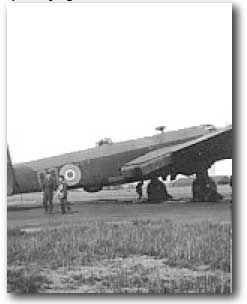
133 Halifaxes from 408, 415, 420, 424, 425, 426, 427, 429, 432, and 433
squadrons were joined by 57 Lancasters from 419, 428, 431, and 434 squadrons on an attack at Hannover. The crews were over the target at between 18,000 to 20,000 feet, releasing 1,587,000 lbs of high explosives. According to reports, bombing was scattered through out the city.
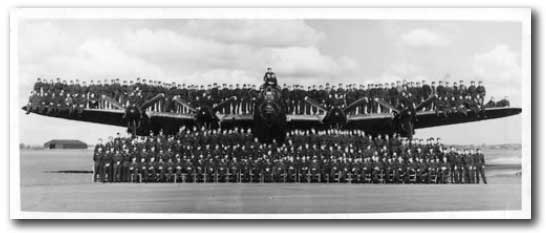
- No 424 Squadron Photo
F/O N. Patterson from 432 squadron was hit by flak, there were holes in the stbd
fuselage and bomb bay. F/Lt J. Thompson and crew, flying Halifax VII NP-705 coded QO-Y, were attacked by a JU-88, there was no claim or damage, although some strikes were seen. F/Lt. J. Sales, RCAF and crew flying Halifax VII NP-759, coded QO-C, failed to return from this operation.
Sgt. J. Dalton, RAF--POW
F.O J. Marcille, RCAF--POW
F/Sgt. S. Aikens, RCAF--POW
W/O2 R. Young, RCAF--POW
P/O C. McInnes, RCAF
F/Sgt. J. Charles, RCAF--POW
2 crew members were killed and 5 POWs.
W/Cdr. J. Stephenson, RCAF--POW and crew flying Halifax VII NP-817, coded QOD, failed to return from this operation.
Sgt. B. Hodges, RAF--POW
F/O W. Fleming, RCAF--POW
F/O R. Donaldson, RCAF--POW
F/O E. Pickthorne, RCAF--POW
W/O1 W. McMahon, RCAF--POW
F/O T. Bond, RCAF--POW
All were POWs.
5 hours and 40 minutes in the air.
Thirty-one crews failed to return, 4.7% of the total, of which ten were from No.
6 Group and three from No. 435 squadron. Sergeant E.J. Faulkner, a flight
engineer on No 425 SQuadron, ecalled. “We were in sight of the target and preparing for the bombing run. Suddenly we were perforated with cannon shells from below. With their
machine out of control and on fire, the crew bailed out Five were taken
prisoner, but two of the gunners were killed. The enemy had ample warning. Cloud prevented the low-level approach originally planned, ground radars picked up the stream in good time. Fighters, including a number of jets, were scrambled in usual strength.
January 6, 1945 (Mission 22)
Taking off at 3:47 p.m. flying Halifax QO-M 132 Halifaxes from 408, 415, 420, 424, 425, 426, 427, 429, 432, and 433
squadrons were joined by 57 Lancasters from 419, 428, 431, and 434 squadrons on an attack at Hanau. The crews were over the target at between 18,000 to 20,000 feet, releasing 522,000 lbs of high explosives and 954,000 lbs of incendiaries. This attack was aimed at the important rail junction. This area was seriously damaged as well as a large portion on the built up area.
6 hours and 35 minutes in the air.
January 13, 1945 (Mission 23)
Taking off at 2:30 p.m. flying Halifax QO-O. 130 Halifaxes from 408, 415, 420, 424, 425, 426, 427, 429, 432, and 433
squadrons were ordered on an attack on the rail yards at Saarbrucken. The crews
were over the target at between 17,000 and 20,000 feet, releasing 892,000 lbs of high explosives. According to reports, bombing was accurate and severe damage was caused.
F/O W. Mennie from 432 squadron was hit by flak, not serious.
7 hours in the air.
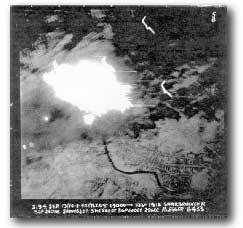
- Strike over Saarbrucken, January 13/14, 1945 by the Egger crew of 433 Squadron
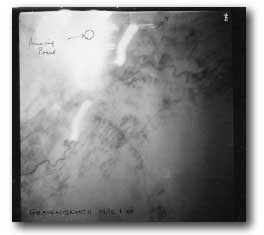
- Strike over Grevenbroich, January 14/15, 1945 Graciously supplied by Clyde Marshall
6 hours in the air.
January 15, 1945
Taking off at 2:01 p.m. doing 3 hours and 20 minutes of bombing practice.
January 14, 1945 (Mission 24)
Taking off at 3:34 p.m. flying Halifax Z.
136 Halifaxes from 408, 415, 420, 424, 425, 426, 427, 429, 432, and 433
squadrons were ordered on an attack on the rail yards at Grevenbroich. The crews
were over the target at between 16,000 and 19,000 feet, releasing 799,000 lbs. of high explosives. According to reports the rail yards were well hit.
January 16, 1945 (Mission 25)
Taking off at 6:55 p.m. flying Halifax H.
127 Halifaxes from 408, 415, 420, 424, 425, 426, 427, 429, 432, and 433
Squadrons were ordered on an attack at Magdeburg. The crews were over the target
at between 18,000 and 20,000 feet, releasing 232,000 lbs of high explosives and 546,000 lbs of incendiaries. According to reports, severe damage was caused.
6 hours and 50 minutes in the air.
January 28/29, 1945 (Mission 26)
Taking off at 7:27 p.m. flying Halifax Q.
124 Halifaxes from 408, 415, 420, 424, 425, 426, 427, 429, and 432 squadrons were joined by 55 Lancasters from 419, 428, 431, and 434 squadrons were
ordered to attack Stuttgart. The crews were over the target at between 18,000
and 20,000 feet, releasing 774,000 lbs of high explosives and 483,000 lbs of
incendiaries. According to reports, the target was cloud covered and bombing was scattered. F/O L. Maguire and crew from 432 Squadron, flying Halifax VII NP-694 coded QO R, were attacked by a JU-88, many strikes were seen and it was claimed damaged. They landed at Polebrook on return due to poor weather at base. S/Ldr S. Minhinnick landed at Tangmere on return due to poor weather at base. F/Lt L. Kroft landed at Grafton Underwood on return due to poor weather at base.
F/O A. Clarke, P/O J. Kinniburgh, P/O R. Proud, F/Lt F. Horan, F/O J. Patterson,
P/O E. Patzer, F/O A. Potter, F/Lt A. Bews, F/O J. Hamilton, F/Lt W. Mennie, P/O G.
Sherlock, and F/O L. Loppe landed at Polebrook on return due to poor weather at base.
7 hours in the air, landing at Polebrook.
January 29, 1945
Flying from Polebrook back to base.
Having 46 hours and 15 minutes with the 432 squadron. Largely because of the weather, major night operations were clustered into short periods of intense activity during the first and third week of January.
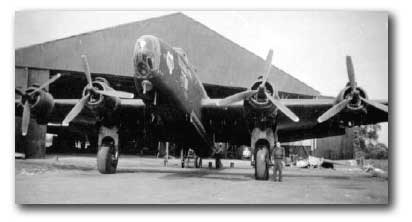
- Halifax VII NP-736 QO-B of 432 Squadron in front of a hanger at East Moor
February 1, 1945
Taking off at 4:08 p.m. flying Halifax QO-J 86 Halifaxes from 408, 415, 420, 425, 426, 427, 429, and 432 Squadrons were
ordered on an attack at Mainz. The crews were over the target at between 18,000
to 20,000 feet, releasing 162,000 lbs of high explosives and 399,000 lbs of
incendiaries. According to reports the target was cloud covered and bombing was scattered. F/Lt. K. Ellson from 428 Squadron was hit by flak, not serious.
6 hours and 50 minutes in the air.
February 2 1945 (Mission 27)
Taking off at 8:07 p.m. flying Halifax QO-A
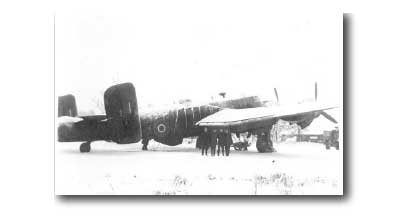
- Halifax VII NP-755 QO-A of 432 Squadron
109 Halifaxes from 408, 415, 420, 425, 426, 427, 429, and 432 squadrons were ordered on an attack at Wanne-Eickel. The crews were over the target between 17,000 and 20,000 feet, releasing 675,000 lbs of high explosives. According to reports, the target was cloud covered and bombing missed the oil refinery. There was, however some damage to a coal mine.
5 hours and 40 minutes in the air.
The winter months of 1944-45 with their long periods of fog and rain caused a
decrease in the high tempo of the Group's operations. By early spring of 1945, the Group's pace again quickened in the final all-out offensive. Targets however, were rapidly becoming scarcer as the Allied armies drove into Germany from east and west.
The enemy's fighter defenses were overwhelmed and daylight attacks, with escorts of long-range Mustangs and Spitfires, were carried out with little loss.


